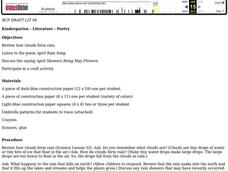Curated OER
Bringing Rain
Students research folklore and scientific information about rain and water cycles. Then they communicate their understanding of water cycles by creating mobiles showing each stage. Students also write their own folk tales, explaining the...
Curated OER
Storms and Extreme Weather
Students explore hurricanes and tornadoes by conducting an experiment. For this weather pattern lesson, students define many extreme weather vocabulary terms and discuss the relationship with static electricity. Students utilize plastic...
Curated OER
Watch the Sky: Observing Clouds and Patterns
Students observe clouds outside of the classroom. In this weather lesson, students investigate and record the clouds above their classroom everyday for three weeks. The students then analyze their data and discuss what causes specific...
Curated OER
Introduction to Severe Weather Patterns
Students review basic weather concepts and terminology, and explore weather modeling tools.
Curated OER
What is Weather?
In this weather instructional activity, students photograph and record the weather conditions for a week. Then they list the types of clouds observed and the weather conditions they noted associated with each cloud type. Students also...
Curated OER
Weather Patterns
In this weather worksheet, students identify with the symbols found on a weather map that show the locations of fronts, high- and low-pressure areas, and various types of precipitation across the United States. Then they use the map...
Curated OER
What Is the Weather Like Today?
In this word/picture association worksheet, learners read 9 sentences that describe a weather condition. Students then match each statement with a picture of that kind of weather. This is intended for ESL use.
Curated OER
ESL: What is the Weather Like?
For this ESL weather worksheet, students listen to description of weather conditions found beneath their pictures, then listen again and check the correct answer when they hear the pattern described and complete a weather crossword puzzle.
Curated OER
Compare and Contrast
Students learn about similarities and differences between different types of weather patterns. For this weather lesson, students read Cloudy With a Chance of Meatballs and Weather. Students create a word search puzzle, complete a Venn...
Curated OER
Weather and Climate
Students identify the words plain and climate and discuss what would happen if it never rained. Students identify and interpret the weather in Poland and create a web illustrating various weather patterns. Students write a 4-line poem...
Curated OER
Cloud Watcher
Students predict weather by watching the clouds, and identify different types of clouds.
Curated OER
Strawberry Girl: Life on the Frontier
Students explore geographic changes by researching the state of Florida. In this Florida history lesson, students identify the storms and disasters that have created sinkholes in portions of Florida. Students read the book Strawberry...
Curated OER
Poetry
Students review how clouds form rain, listen to the poem April Rain Song, discuss the saying April Showers Bring May Flowers, and participate in a craft activity.
Curated OER
Cloudy With a Chance of...
Students listen to the story, "Cloudy With a Chance of Meatballs". Then the class creates their own version of the story with a theme of their choice. In small groups, they write and illustrate a paragraph for the class book.
Curated OER
Celebrate The Four Seasons
Students investigate cause and effect and compare and contrast how recurring cycles are evident in multiple aspects of their education. They answer questions in the chosen field. Students model each aspect by interpreting, perceiving and...
















